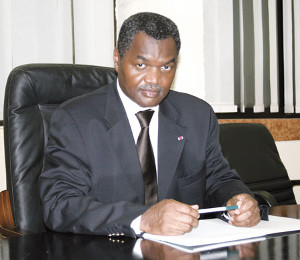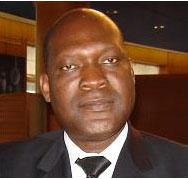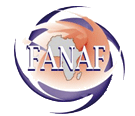FANAF, new stage, new president
Results and prospects
Atlas provides its readers with a quick overview of the actions taken by the president Protais Ayangma during the past six years along with a presentation of Adama Ndiaye’s program.
Protais Ayangma, achievements more than satisfactory
 Protais Ayangma, outgoing FANAF’s president Protais Ayangma, outgoing FANAF’s president |
Chosen at the top of FANAF in 2008, Protais Ayangma is nearing the end of his second term with more than satisfactory results. His initiatives, primarily focused on training, communication and consolidation, have allowed the market to undertake profound reforms.
The most notable accomplishment to the credit of the outgoing president is the amendment of article 13 of the CIMA code, making premium payment compulsory prior to any underwriting or renewal of an insurance contract. As a result, the premium arrears are down sharply while companies have improved cash flow well enough to meet their commitments.
This success should not overshadow the special interest exhibited by outgoing team in the motor guarantee fund (FGA), an essential body for better management of road accident victims. Several countries have adopted this system like Senegal, Côte d' Ivoire, Benin and Gabon.
Training has also been the highlight of the last two terms. Many seminars, training sessions, study tours have been organised for the staff of insurance companies.
As for communication, FANAF’s general meetings have grown over the years into an unmissable event. Modernization and regular updating of the website have enabled the organization to raise awareness about the actions undertaken by the management team. As of 2010, FANAF has established the Julien Jean Codjovi Award for the promotion of research in insurance, reinsurance and related subjects along with the Ahmadou Kourouma Award, designed for national insurance markets.
Other actions have also been the object of significant advances such as:
- improving corporate governance,
- strengthening supervision of intermediaries,
- adoption of microinsurance regulations,
- monitoring reinsurance,
- implementation of the first life tables specific to the CIMA zone.
Finally the outgoing team has undertaken several projects worth consolidating and finalizing by the future successor, the most important of which is the reform of the system designed for the compensation of bodily injury resulting from road accidents.
Adama Ndiaye, seul candidat en lice pour la présidence de la FANAF
 Adama Ndiaye, the only running candidate for FANAF’s presidency Adama Ndiaye, the only running candidate for FANAF’s presidency |
Member of the outgoing executive committee, Adama Ndiaye holds a postgraduate diploma delivered by the Yaoundé’s insurance institute in Cameroon. A. Ndiaye has served for many years as controller within CIMA before joining Aveni Re as deputy general manager, a position he quit in 2013.
Adama Ndiaye’s program for FANAF’s presidency is a combination of continuity and innovation.
It is primarily designed to consolidate all the gains and to achieve the actions undertaken during the last two terms. It then aims at innovating and confirming the presence of FANAF in the African insurance landscape.
Priorities revolve around four axes:
- Reform of FANAF’s general secretariat
Given the challenges to meet, this body should be provided with necessary human and material resources.
Among the proposals of the new team, we may note the following:
- overhauling legislation to establish transparent governance,
- modification of the statutes,
- reshaping the organization and the procedures.
- The establishment of an exchange framework with CIMA. A more balanced cooperation with CIMA is promoted through:
- more active participation in projects,
- creating a joint think tank to examine future regulatory developments.
- Enhancing the visibility and role of insurance in society. Establishment of a partnership and a framework for the exchange of experiences and information between FANAF and various local, regional and international actors.
- Coordinating activities among various stakeholders. The new team advocates greater involvement of FANAF partners: intermediaries, reinsurers, experts, trainers, …
In this regard, A. Ndiaye provides:
- pooling training initiatives, provided by different stakeholders with a view to create a synergy between programs and corporate needs,
- adoption of a joint communication strategy,
- establishing a consistent approach to problem solving in partnership with associations of intermediaries, associations, reinsurers, actuaries, …
The FANAF zone market, overview in 2012
 |
As at December 31, 2012, The turnover of the FANAF region, which includes 16 countries, has evolved faster than the entire continent (3.77%). From the 1.582 billion USD of premiums collected in 2011, FANAF market rose to 1.797 billion USD, an increase of 13.65%. In five years, that is, from 2008 to 2012, premiums volume increased by 30.36%.
Breakdown of life and non- life premiums: 2008-2012
With a 72.49% market share, non-life insurance remains dominant in the region. Constantly evolving, life insurance reported the highest growth in 2012, (+14.40 %). Over five years, from 2008 to 2012, this segment has grown by 38.84 %.
Evolution of premiums 2008-20121
in millions USD| 2008 premiums | 2009 premiums | 2010 premiums | 2011 premiums | 2012 premiums | 2012 shares | |
|---|---|---|---|---|---|---|
Life | 356.24 | 380.58 | 409.32 | 432.36 | 494.61 | 27.51% |
Non life | 1 022.93 | 1 116.60 | 1 110.06 | 1 149.64 | 1 303.33 | 72.49% |
Total | 1 379.17 | 1 497.18 | 1 519.38 | 1 582 | 1 797.94 | 100% |
Premiums' growth rates 2008-2012
| 2008/2009 evolution | 2009/2010 evolution | 2010/2011 evolution | 2011/2012 evolution | 2008/2012 evolution | |
|---|---|---|---|---|---|
Life | 6.83% | 7.26% | 5.63% | 14.40% | 38.84% |
Non life | 9.16% | -0.59% | 3.57% | 13.37% | 27.41% |
Total | 8.56% | 1.48% | 4.12% | 13.65% | 30.36% |
Breakdown of premiums per country
By the end of 2012, the FANAF market was still dominated by five countries that generate 66.92% of premiums: Côte d'Ivoire (23.09%), Cameroon (16.38 %), Gabon (11%), Senegal (10.20%) and Congo Brazzaville (6.25%). All regional countries have posted increasing turnover. Nine out of 16 countries reported a double-digit growth such as Congo Brazzaville (+51.20%), Chad (+28.27%) and Guinea Conakry (+25.22%).
Evolution of premiums per country: 2008-2012
in millions USD| 2008 | 2009 | 2010 | 2011 | 2012 | 2011/2012 evolution | 2012 shares | |
|---|---|---|---|---|---|---|---|
Côte d’Ivoire | 354.68 | 368.08 | 381.74 | 352.03 | 415.27 | 17.96% | 23.09% |
Cameroon | 232.99 | 247.17 | 247.70 | 266.15 | 294.47 | 10.64% | 16.38% |
Gabon | 142.89 | 158.79 | 163.75 | 176.02 | 197.78 | 12.36% | 11.00% |
Senegal | 166.42 | 170.56 | 171.67 | 177.17 | 183.31 | 3.46% | 10.20% |
Congo Brazzaville | 62.12 | 76.40 | 63.36 | 74.31 | 112.36 | 51.20% | 6.25% |
Rwanda 1 | 65.23 | 85.35 | 85.65 | 101.19 | 109.95 | 8.65% | 6.12% |
Burkina Faso | 54.91 | 62.70 | 72.27 | 70.06 | 85.43 | 21.93% | 4.75% |
Togo | 45.16 | 51.36 | 56.63 | 69.09 | 75.38 | 9.10% | 4.19% |
Benin | 62.33 | 65.70 | 64.94 | 65.81 | 68.74 | 4.45% | 3.82% |
Mali | 43.25 | 43.87 | 45.54 | 53.08 | 57.08 | 7.53% | 3.17% |
Madagascar 2 | 54.85 | 54.89 | 54.92 | 54.95 | 55.00 | 0.10% | 3.06% |
Niger | 30.53 | 36.17 | 36.23 | 38.60 | 44.02 | 14.04% | 2.45% |
Guinea Conakry 3 | 11.45 | 14.09 | 12.41 | 22.36 | 28.00 | 25.22% | 1.56% |
Chad | 13.14 | 18.40 | 17.03 | 15.83 | 20.30 | 28.23% | 1.13% |
Burundi | 11.66 | 13.05 | 12.08 | 11.77 | 12.26 | 4.16% | 0.69% |
Central African Republic | 5.94 | 6.42 | 6.53 | 7.14 | 8.24 | 15.40% | 0.46% |
Direct business | 1 357.55 | 1 473.00 | 1 492.45 | 1 555.56 | 1 767.59 | 13.63% | 98.32% |
Acceptances | 21.62 | 24.18 | 26.93 | 26.44 | 30.35 | 14.78% | 1.68% |
Total | 1 379.15 | 1 497.18 | 1 519.38 | 1 582.00 | 1 797.94 | 13.65% | 100% |
2 Source: ARO for the 2008 and 2011 figures. Atlas estimates for the years 2009, 2010 and 2012.
3 Source: Central bank of the republic of Guinea for 2008 and 2011 figures. Atlas estimates for the 2012 figures.
Exchange rate FCFA/USD as at 31/12 | 2008 | 2009 | 2010 | 2011 | 2012 |
0.00212 | 0.00214 | 0.00198 | 0.00193 | 0.00201 |
